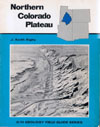Resource Book Purchase Information
Information from various parts of these books was kindly provided by the authors. Please help support them and their research by purchasing their publications at the below locations. Special thanks to the Late Ken Hamblin for allowing me into his home to get copies of many of his amazing areal photos, as well as to J. Keith Rigby for giving verbal permission to use content from his out of print guide books.
![]() Click picture for close up view
Click picture for close up view
Geologic History of Utah
(Brigham Young University geology studies)
by Lehi F. Hintze
Purchase from the BYU Geology Department
Purchase from the Utah Geologic Survey
Purchase from Amazon.com
Field Guide: Northern Colorado Plateau
by J. Keith Rigby
Out of print-
Purchase used from Amazon.com
Beyond the Visible Landscape
by Kenneth Hamblin
Purchase from the BYU Geology Department
Purchase from the BYU Bookstore
Images in the Formation Image Database (flickr and google images galleries)
These images were taken as a government employee and are thus in the open domain. Citing the Utah Geological Survey and/or lanceweaver & utahgeology.com would be appreciated, but is not required.
Stratigraphic Column Data
In regard to Stratigraphic Column Data. Open Domain government USGS and UGS publications form the basis for most, if not all, stratigraphic columns on this site.
Stratigraphic Column data is likely not subject to copyright. Use at will.
U.S. Copyright Law for Data
This is an extract of the copyright law, concerning tabular data, from the Library of Congress’s United States Copyright Office (full version also available in .pdf format). It explains that copyright protection is available for “originality” not “sweat of the brow” or work done to produce something. Concerning “unadorned facts”, regardless of the time it took to create the work, it is the “originality” of the organization/display of that work which is copyrightable. This is illustrated in the supreme court ruling shown in the example below where the court ruled that the data in a phone book was not copyrightable, even though considerable time and effort went into creating it. It was decided that neither the information nor the format in which it was presented was copyrightable because it contained “unadorned facts” displayed according to an accepted standard.
EXTENT OF COPYRIGHT PROTECTION
“Copyright protection extends to the compilation of facts if the compilation represents original authorship. In some instances some or all of the contents of a database, new or revised, may also be copyrightable, as in the case of a full- text bibliographic database. Copyright protection is not available for:
- ideas, methods, systems, concepts, and layouts
- individual words and short phrases, individual unadorned facts; and
- the selection and ordering of data in a database where the collection and arrangement of the material is a mechanical task only, and represents no original authorship; e.g., merely transferring data from hard copy to computer storage
Example
Feist Publications, Inc. v. Rural Telephone Service Co., 499 U.S. 340 (1991) Rural Telephone Service Company and Feist Publications, Inc., are both publishers of telephone directories. When Rural refused to license its white pages listings to Feist for a directory covering 11 different telephone service areas, Feist extracted the listings it needed from Rural’s directory without Rural’s consent. Although Feist altered many of Rural’s listings, several were identical to listings in Rural’s white pages. The District Court granted summary judgment to Rural in its copyright infringement suit, holding that telephone directories are copyrightable. The Court of Appeals affirmed. The Supreme Court reversed the judgment of the Court of Appeals holding that Rural’s white pages did not meet the constitutional or statutory requirements for copyright protection, stating that, originality, not “sweat of the brow,” is the touchstone of copyright protection in directories and other fact-based works. Raw data are uncopyrightable facts, and the way in which Rural selected, coordinated, and arranged those facts was not original in any way. Copyright rewards originality, not effort.”




